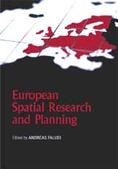premio gubbio 2018 identity giornata di studi inu paesaggio welfare ifau2018 smart city local development educational job special news technology inu study day collaborative urban design open position urban practices sprawl governance immigration simulation conferences economics urban form adi energy
European Spatial Research and Planning
edited by Andreas Faludi
With the publication of European Spatial Research and Planning, the Lincoln Institute adds a third volume to its series of investigations of spatial planning, research, and policy in Europe, all of them edited by Andreas Faludi. The previous titles are Territorial Cohesion and the European Model of Society (2007) and European Spatial Planning (2002). Each of these books examines the European experience with spatial planning, with an expectation that it may hold lessons for land policy in the United States.
This new book taps into the treasure trove of research that is ESPON, the European Spatial Planning Observation Network, which has yielded a plethora of studies on the real and anticipated outcomes of European territorial policy. The ESPON research underpinning this volume reveals that policy goals such as sustainable economic growth and territorial cohesion have far-reaching consequences across sectors and geography. The ESPON corpus provides the chapter authors with the means to examine developments at the intersection of research and policy.
As with the previous two volumes, the approach to this book began with inviting a select group of people from all over Europe to give papers on their experience with various aspects of ESPON’s work. The seminar took place at the University of Luxembourg in May 2007.
The chapters provide a comprehensive view of how the search for evidence to support the agenda of the European Spatial Development Perspective (ESDP)—now the Territorial Agenda—has proceeded, what the evidence has been in some key areas, what the implications are, and what other conclusions could have been drawn. The authors also demonstrate that a learning exercise like ESPON can contribute to shaping a political agenda, which could perhaps serve as a source of inspiration for fellow planners across the Atlantic.
Perhaps the most striking area of difference between Europe and the United States in the context of territorial policy has to do with demography. Europe is facing a population deficit by mid-century of the same order as the expected increase in U.S. population in that period. While it is true that the United States has by no means come to grips with its own immigration issues, it is perhaps still fair to observe that immigration policy will continue to contribute significantly to the tension between Europe’s continental vision, and its place within a greater regional neighborhood, and the wider world.
The book features more than 30 full-color maps and numerous other figures that illustrate the concepts and trends discussed. Many of these images were developed directly through ESPON research.
CONTENTS
Foreword
Preface
Introduction, Andreas Faludi
• Organization, Achievements, and the Future of ESPON
Cliff Hague and Verena Hachmann
• Territorial Impact Analysis of EU Policies
Kai Böhme and Thiemo W. Eser
• Polycentricity under the Looking Glass
Janne Antikainen
• Planning for Decline: The Demographic Imperative
Diogo de Abreu
• The Shrinking Continent: Accessibility, Competitiveness, and Cohesion, Klaus Spiekermann and Michael Wegener
• Response to Natural Hazards and Climate Change in Europe
Philipp Schmidt-Thomé and Stefan Greiving
• Figuring Out the Shape of Europe: Spatial Scenarios
Jacques Robert and Moritz Lennert
• North-South Regionalism: A Challenge for Europe in a Changing World
Pierre Beckouche and Claude Grasland
• The Europeanization of Planning
Kai Böhme and Bas Waterhout
• The Making of the Territorial Agenda of the European Union: Policy, Polity, and Politics
Thiemo W. Eser and Peter Schmeitz
EDITOR:
Andreas Faludi is a faculty associate at the Lincoln Institute and professor at OTB Research Institute for Housing, Urban and Mobility Studies, Delft University of Technology in The Netherlands.
He has written extensively on planning theory and on Dutch and European planning, including European Spatial Planning (Lincoln Institute, 2002).
Online resources and links




Planum
The Journal of Urbanism
ISSN 1723-0993
owned by
Istituto Nazionale di Urbanistica
published by
Planum Association
ISSN 1723-0993 | Registered at Court of Rome 4/12/2001, num. 514/2001
Web site realized by ChannelWeb & Planum Association | Powered by BEdita 3

